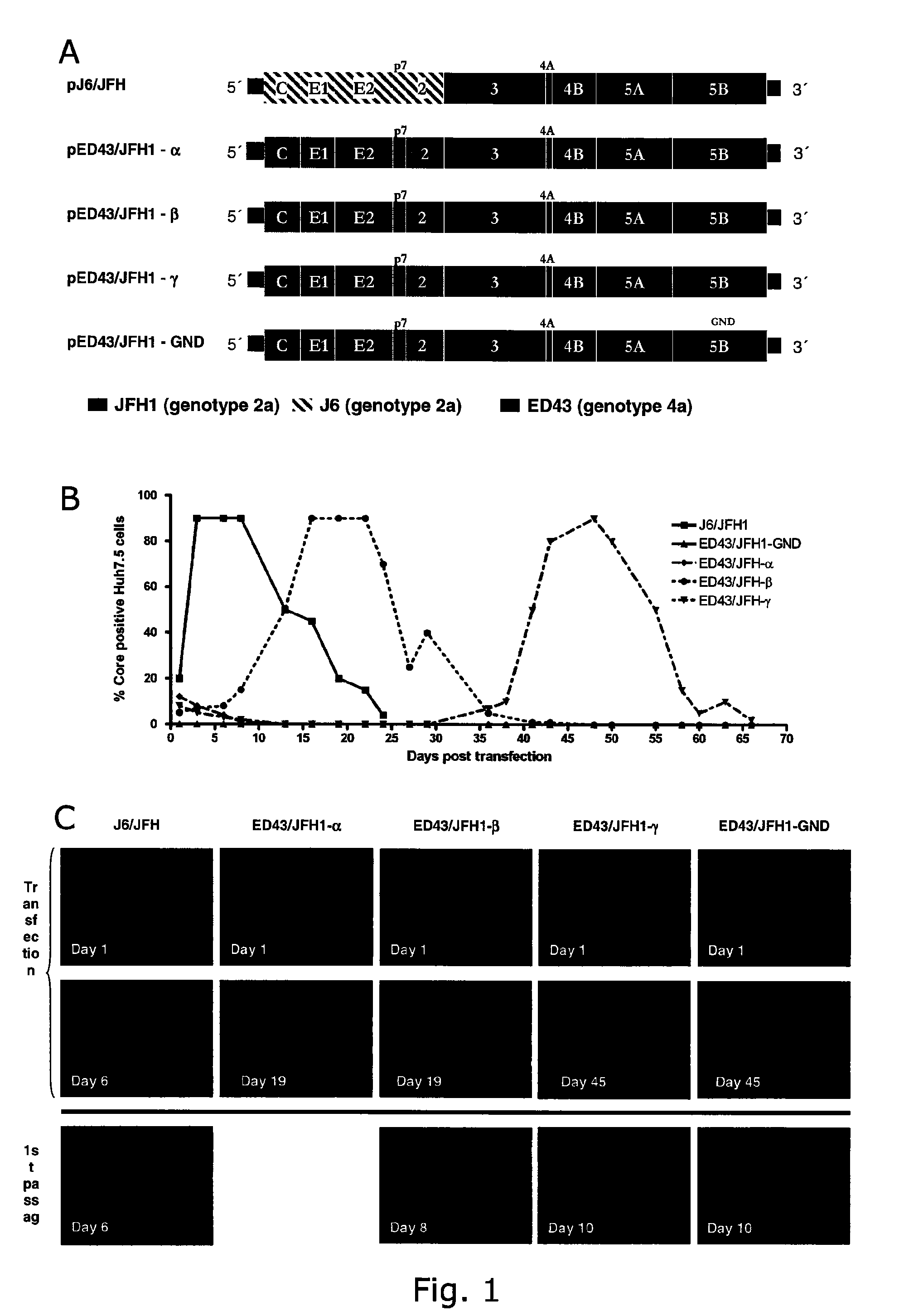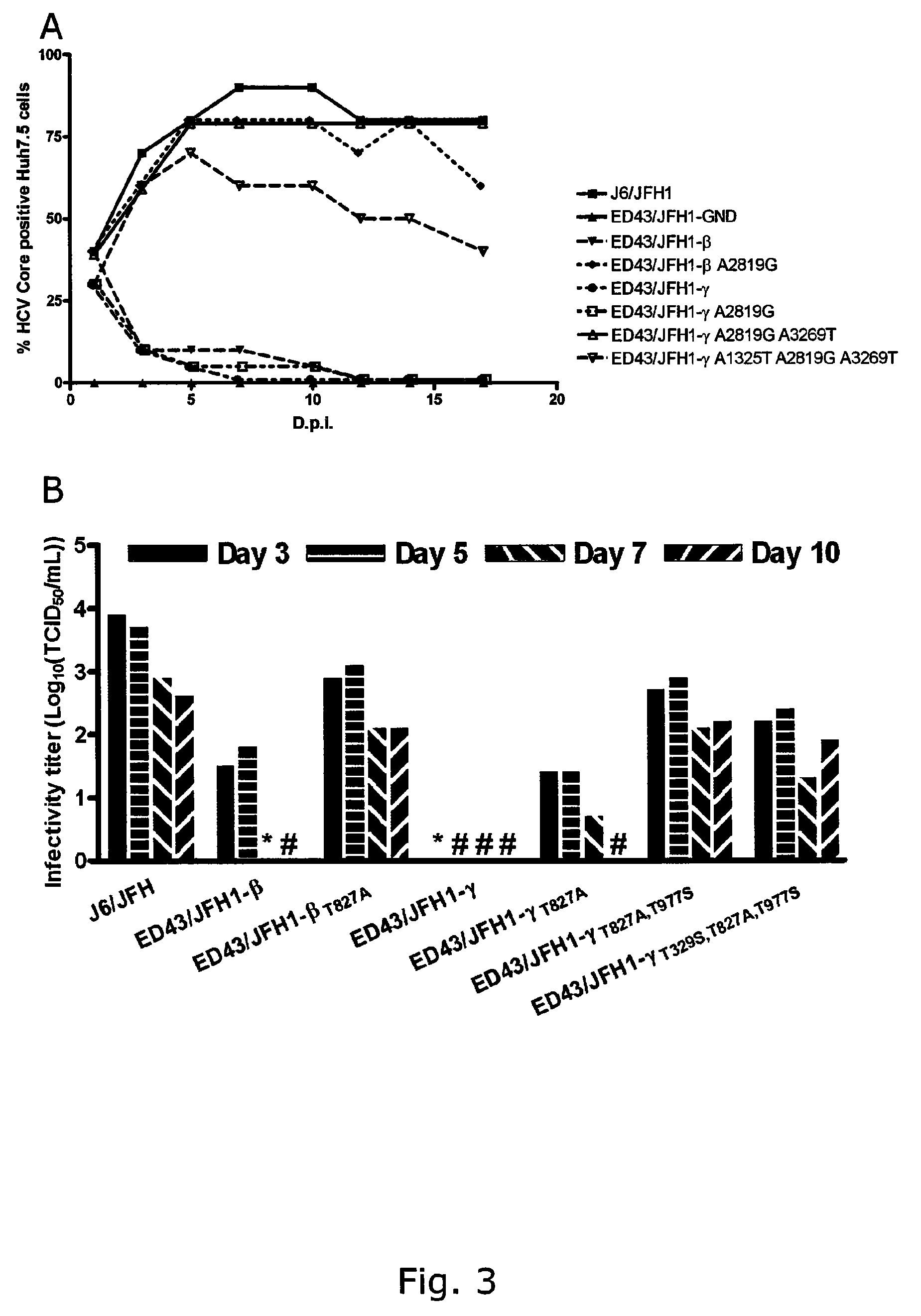Adaptive mutations allow establishment of JFH1-based cell culture systems for hepatitis C virus genotype 4A
a hepatitis c virus and cell culture technology, applied in viruses/bacteriophages, antibody medical ingredients, recovery/purification, etc., can solve the problems of increased risk of liver cirrhosis, hepatocellular carcinoma, high treatment cost, etc., and achieve the effect of enhancing potential
- Summary
- Abstract
- Description
- Claims
- Application Information
AI Technical Summary
Benefits of technology
Problems solved by technology
Method used
Image
Examples
example 1
In Vitro Infectivity of ED43 / JFH1 Recombinants Depends on Location of the Recombination Point
[0231]In vitro transcribed RNA from pED43 / JFH1-α, -β, -γ (SEQ ID NO 5, 1 and 2) and -GND as well as pJ6 / JFH (positive control), was transfected into Huh7.5 hepatoma cells. ED43 / JFH1-α, -β and -γ replicated as evidenced by anti-Core immunostaining at day 1 (FIGS. 1B and C). While J6 / JFH infected most Huh7.5 cells (80-100%) within 3 days, the percentage of ED43 / JFH1 antigen positive cells decreased. Subsequent viral spread to most cells in the culture was observed for ED43 / JHF1-β at day 16 and for ED43 / JFH1-γ at day 43 (FIGS. 1B and C). Cytopathic effects followed by proliferation of infection resistant Huh7.5 cells, occurred after infection spread to most cells. Full culture infection was generally seen for approximately 5-10 days. The delayed production of infectious ED43 / JFH1-β and -γ viruses was confirmed by infectivity titration using the tissue culture infectious dose-50 method (TCID50, ...
example 2
ED43 / JFH1 Viral Spread Kinetics Resembles J6 / JFH while the Specific Infectivity Titers Appear to be Lower
[0232]J6 / JFH and ED43 / JFH1-β and -γ in a total of four cell free passages were serially passaged. Peak genome titers around 107 IU / mL (IU, International Units) were obtained in all experiments, with J6 / JFH peaking at 107,7 IU / mL in 4th passage, ED43 / JFH1-β at 107,3 IU / mL in 1st and 4th passage and ED43 / JFH1-γ at 107,2 IU / mL in 4th passage. J6 / JFH showed infectivity titers of up to 105,1 TCID50 / mL, while the genotype 4 recombinants peaked at 103,5 and 103,6 TCID50 / mL, respectively (Table 4). Inconsistency between genome titers and infectivity titers in J6 / JFH and the two genotype 4 recombinants was reflected by a difference in specific infectivity (infectious doses per genomes measured in IU). For J6 / JFH specific infectivities of 1:100 were observed. Specific infectivities of 1:1600 only was observed for ED43 / JFH1-β and -γ.
[0233]In order to directly compare the spread and infectiv...
example 3
[0234]Identification of putative adaptive mutations in recovered ED43 / JFH1 viruses. The significantly extended time needed for the 4a / 2a recombinants to spread in transfection culture relative to subsequent passages may be indicative of requirements of adaptation. Thus, viral RNA was isolated from supernatant at high-titer time points (same used for passage) in 1st, 2nd and 3rd passage, and the complete ORF sequences were analyzed by direct sequence analyses of overlapping nested RT-PCR amplicons. Putative adaptive mutations were found as indicated in Table 5 (A-B). Noteworthy regarding recovered ED43 / JFH1-β viruses is the occurrence of one coding mutation in the ED43 part of NS2 (A2819G), which changed completely already in 1st passage. No other dominating coding mutations where observed, except for an NS5A mutation (G7646T) present only in virus recovered from 3rd passage. The NS2 mutation A2819G appeared to be essential for the viability of ED43 / JFH1 recombinants, since the same ...
PUM
| Property | Measurement | Unit |
|---|---|---|
| nucleic acid | aaaaa | aaaaa |
| immunogenic composition | aaaaa | aaaaa |
Abstract
Description
Claims
Application Information
 Login to View More
Login to View More - R&D
- Intellectual Property
- Life Sciences
- Materials
- Tech Scout
- Unparalleled Data Quality
- Higher Quality Content
- 60% Fewer Hallucinations
Browse by: Latest US Patents, China's latest patents, Technical Efficacy Thesaurus, Application Domain, Technology Topic, Popular Technical Reports.
© 2025 PatSnap. All rights reserved.Legal|Privacy policy|Modern Slavery Act Transparency Statement|Sitemap|About US| Contact US: help@patsnap.com



